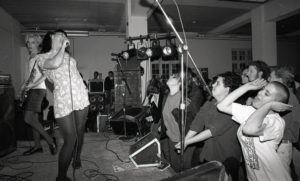
Bikini Kill
1990’s America was stale, laddish and male dominated. It was littered with double standards. In 2015, The New York Times’s Kurt Anderson reminisced on the era as, “The Best Decade Ever”. In doing so, he thanked Starbucks for the “sudden availability of excellent coffee.” Anderson however, made no reference to the Riot Grrrls.
An underground subculture that emerged in the West Coast, the Riot Grrrls combined feminist consciousness with a punk style. At the time that Nirvana were exploding with the legendary album Nevermind, the girls were rebelling for their voices to be heard in their music, activism and publishing. Throughout the 1990s those involved performed biting songs and created magazines (“fanzines”) that tore apart the fictitious and dangerous rule book of how girls should act and think.
The formation of all-female or female led bands altered the balance of women musicians in the punk and rock music scenes and bought them to the front. Mainly punk and new wave bands; loud and reckless, the leaders were Heavens to Betsy, Bikini Kill and Bratmobile. They called for Revolution, Girl Style, Now!, the title of Bikini Kill’s first album.
In facing the problems in the heavily male ruled music industries whilst maintaining the heart of do-it-yourself punk, the bands wanted to make a change in the society that they lived in. Girls can shout. Girls can sweat. Girls can think. Girls can stand up. Though of course they faced problems.

Kathleen Hanna
By creating their own zines that laid out the manifestos and the aims of the movement, the Riot Grrrl movement was keen to avoid the press; in fear of the judgements they may face in changing the status quo. To avoid being called names and conclusions being jumped to, many of the females involved would write words like “SLUT”across their bodies. They’d do so in their lyrics too, shouting the jibes and the sneers they’d heard before. Kathleen Hanna, the pioneering front-woman of Bikini Kill, would regularly perform snarling her lyrics “I can sell my body if I wanna‚” (“Jigsaw Youth”) with words scrawled across her torso.
In doing so, she defied what’s called the “male gaze” a theory that suggests that humans look at each other through a masculine view and therefore sexualize women in particular as objects or vice versa, (weird, huh?). She turned that on its head by controlling her own sexuality, objectifying herself, before any other male gaze could. With this, Hanna also took ownership of her body and responsibility over it.
This wasn’t a normalized act, and although we see more elements of it now with women feeling confident enough to wear the clothing they’d like and creating their own style, in the 1990’s that sort of expression wasn’t a standard part of womanhood. The Riot Grrrls rejected the ideas of female look and behavior; sometimes they’d sing cutesy lyrics about pie in a pink dress, but back it with big boots and a killer riff that felt it could fall apart at any moment.
Kathleen Hanna could easily dominate the legacy of the Riot Grrrls; it was she who demanded “girls to the front” at all of her gigs and has appeared in many musical projects alongside Bikini Kill, like Le Tigre and The Julie Ruin. She stills makes music, performs, writes and lectures today. Her 2013 biopic, The Punk Singer, takes a look at the life of the cultural icon who has changed the life and the attitude of many.
The Riot Grrrls have and will continue to inspire.
-Tanyel Gumushan
Take-Over Blogger
Alternative Girl
